Centauri Dreams
Imagining and Planning Interstellar Exploration
SETI: Project Argus and the Long Stare
I think you’ll find Jon Lomberg’s new essay in Slate as interesting as I do. We Need a World Cup for SETI uses a familiar figure at many sports events — the guy in the stands holding up a Biblical reference on a poster — to dig into a far more interesting issue. How does one go about maximizing visibility? The guy with the sign knows how to do it and if we think about his methods, we can better understand SETI.
For as we think about radio and optical SETI, we’re usually looking for signals that have been intentionally sent. Here we run into the particularly tricky business of trying to understand the thinking of an alien being, but there are certain principles that may apply to any civilization trying to send out a beacon-like message. The message needs to be short, cheap, easy to find, and in a place where it’s likely to be seen. So what kind of beacon is this going to be?
We’ve discussed ‘Benford beacons’ in these pages before (see, among others in the archive, Detecting a ‘Funeral Pyre’ Beacon). A beacon announcing little more than ‘We Are Here’ could be used to attract the attention of any receiving culture, after which we (the receivers) would apply our resources to looking harder at the source. But from the standpoint of efficiency and economy, a brief, bright beacon is best. James and Gregory Benford have addressed the matter in two key papers cited at the end of this essay. Let me quote a brief bit of one:
No technology available in the near-term will allow us to deliver powerful signals every minute of the day over a span of multiple epochs… But we might be able to make a beacon that works more efficiently, by targeting only those star systems where life seems most likely, and then pinging them each in turn, repeating the cycle every few months or so. Presumably, if a curious civilization caught one transmission, it would train its telescopes on that exact spot until the next part of the beacon’s message arrived. This more sensible approach—a sort of Energy Star specification for SETI—would save enough power to keep the beacon running for millions of years.
The Benfords bring useful synergies to bear on the matter. Jim is a plasma physicist — he knows all about beaming — while Greg is both physicist and science fiction author, a man who has speculated for decades on the workings of extraterrestrial civilizations. Jim’s son Dominic, also active in the beacon work, is a physicist at NASA GSFC. Beacons like the Benfords are suggesting are different from the kind of directed beacon SETI has long looked for, one that demands intense focus on stars in the hopes of finding continually broadcasting signals. A Benford beacon puts out a signal we would perceive as intermittent, a brief pulse.

Image: What kind of signal to look for amidst 200 billion stars? Credit: Center for Planetary Science.
The Long Stare
You can see that this puts the premium on what SETI people call ‘dwell times,’ i.e., the time we look at a particular target. In his Slate essay, Lomberg points out that there is a major timing issue here. Just how long would a beacon like this take before it repeated?
If you ever detect a possible beacon, you have to remain on target long enough for it to repeat—and who knows how long you have to wait? For an ancient and long-lived society, with perspectives far longer than our 10,000-year civilization, that might be a long time. Their notion of patience might be very different from ours. They’re aliens, after all. Of one thing I am sure: Any brief, potentially artificial signal should be closely watched for a repeat. A new approach to SETI could involve unbroken observation of some of the special directions on the sky.
Given that open question, we still need to maximize the possibilities, and I think Lomberg is right in emphasizing a strategy of constant listening. How to do this? Paul Shuch, the canny and deeply dedicated executive director of the SETI League, has long advocated getting away from what he calls ‘soda straw’ SETI, in which we perform a deep study of a target for only a short period of time before moving on. Instead, Shuch backs attempts like Project Argus, the SETI League’s microwave SETI effort aimed at providing continuous, full-sky coverage.
The notion here is to deploy and coordinate about 5000 small radio telescopes around the world, an attempt to provide continuous monitoring of the sky in real time. A station for Project Argus is not a huge dish but an amateur installation fully capable of detecting a Benford beacon’s transient signal if it should occur. In terms of cost, such a site has more in common with amateur radio than with Arecibo-style astronomy. It could be built for no more than a few thousand dollars and, depending on the builder, perhaps for less.

Image: H. Paul Shuch, N6TX, uses the SETI Horn of Plenty antenna for portable operations when away from his Project Argus station FN11lh. The horn, which fits in the back of a minivan, is ideal for classroom demonstrations, exhibiting +20 dBi of gain at 1.4 GHz. Credit: SETI League.
And yes, the famous “Wow Signal,” a one-off detection via Ohio State’s Big Ear radio telescope in 1977, does seem to fit the model of a Benford beacon, in being powerful, brief, and never seen again. How should we look for the next “Wow Signal”? Science fiction author David Brin backs the Project Argus idea in The Search for Extraterrestrial Intelligence (SETI) and Whether to Send “Messages” (METI):
Clearly SETI would benefit from a supplementary system that covers the Earth, searching continuously and broadly for pings that are sent by ETCs narrowly. That system would be ready to detect and pounce upon any new Wow Signals and automatically net-notify larger telescopes to zoom quickly on the source. Not a competitor with classic SETI, this second layer could serve as an ideal alert-generating system, filling a glaring deficit in the current approach.
An Expanded Project Argus
In Greek mythology, Argus was a giant whose epithet “all seeing” (panoptes) spawned depictions of him with multiple eyes. Argus always had a few eyes open, thus becoming the perfect watchman. Can we find a way to maximize the potential of Project Argus?
For while the endeavor is loaded with promise and benefits from the skills and energies of people like Shuch, it has been unable to reach anything like the needed 5000 stations for continuous coverage. This is why a comment by the above-quoted David Brin on a SETI-oriented mailing list recently caught my eye. Brin notes that even as ‘soda straw’ SETI continues, we have the option of energizing the Project Argus idea. We already see wealthy people like Paul Allen and Yuri Milner becoming deeply involved in SETI. What if we could find a similar figure to create a Project Argus kit?
The idea here would be to take the building of a home receiving station for SETI out of the realm of sophisticated electronic technology and into into a turn-key kit that could be purchased for several hundred dollars and simply attached to a basic backyard dish. Like SETI@Home, a Web-based collection system could be used to track the ongoing datastream. A global system for transient detections like this is the kind of network that could find a Benford beacon.
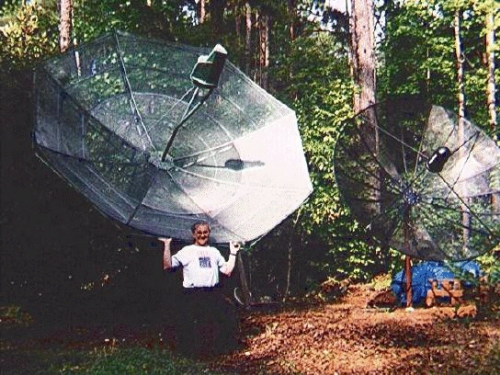
Image: My friend Mike Gingell, KN4BS, shows off his two dishes, 12 and 10 feet in diameter, used for radio astronomy, satellite TV, and of course SETI. I’m sorry to say that Mike passed away last year, but he remained fascinated by SETI prospects until the end. Credit: Mike Gingell / SETI League.
We need to keep an eye on the possibilities that can emerge from private funding and the work of skilled amateur radio astronomers. But we also need to grow the numbers of those who have the means to participate. An updated version of Project Argus could supplement and extend the original, taking what began as a superb idea for engineers working with home equipment into the realm of everyday users with a yen to use digital tools to explore SETI’s possibilities. Make the kit cheap enough and straightforward to operate and the transient detection system we need emerges, an approach to SETI that widens our capabilities even as traditional SETI continues.
The papers are Benford, “Messaging with Cost Optimized Interstellar Beacons,” Astrobiology Vol. 10(5) (June, 2010), pp. 475-490 (preprint) and “Searching for Cost Optimized Interstellar Beacons,” Astrobiology Vol. 10(5) (June, 2010), pp. 491-498 (preprint). Paul Shuch’s Searching for Extraterrestrial Intelligence: SETI Past, Present, and Future (Springer, 2011) is an essential resource on SETI issues.

Catching Up with Dawn at Ceres
The Dawn spacecraft has reached its final orbital altitude, closing to within 385 kilometers of the asteroid (and yes, I really should start calling Ceres a ‘dwarf planet’ consistently — working on it). We have no observations from this distance yet, but that process begins within days, and should give us images with a resolution of 35 meters per pixel, along with a wealth of data from the craft’s scientific package.
Like New Horizons, Dawn makes history every time it returns observations of places we haven’t seen before, or surface features we’re seeing at higher resolution as the orbit lowers. Unlike New Horizons, Dawn is an orbiter, which makes me long for the idea of a Pluto orbiter, even though New Horizons has amply demonstrated how useful and powerful a flyby mission can be. An orbiter lets you complete the mapping process so essential to making a new world tangible, while there are parts of Pluto that our flyby couldn’t make out at highest resolution.
I found the temperatures Dawn recorded at Ceres a bit startling. The 180 K (-93 °C) on the low side seems about right, but I hadn’t expected equatorial temperatures to reach as high as 240 K (-33 °C), which is a temperature I can recall experiencing several times in Iowa during an unusually tough winter. This JPL news release notes that temperatures at and near Ceres’ equator are too high to support surface ice for long periods, as explained in new work published in Nature to which we now turn.
Maria Cristina De Sanctis (National Institute of Astrophysics, Rome) and colleagues tell us in one of the two new papers that Dawn has turned up evidence for clays that are rich in ammonia on Ceres, using data gathered by the spacecraft’s visible and infrared mapping spectrometer. I hearken back to those temperatures because Ceres is too warm to support surface ammonia ice, but ammoniated compounds (ammonia molecules combining with other minerals) could be stable. Finding these tells us that Ceres may not have formed in the main asteroid belt.
“The presence of ammonia-bearing species suggests that Ceres is composed of material accreted in an environment where ammonia and nitrogen were abundant,” says De Sanctis. “Consequently, we think that this material originated in the outer cold solar system.”
The other possibility: The dwarf planet formed about where it is today but drew in materials from the outer system that had formed near the orbit of Neptune. Another interesting finding: Although carbonaceous chondrites (meteorites rich in carbon) are thought to be similar to Ceres in composition, the data do not match at all wavelengths. Ceres shows absorption bands in its reflected light that match up with the ammoniated minerals described above. Moreover, Ceres shows water content as high as 30 percent, while carbonaceous chondrites normally weigh in at 15 to 20 percent bulk water content, possibly indicating accretion from volatile-rich material.
Image: Dwarf planet Ceres is shown in these false-color renderings, which highlight differences in surface materials. Images from NASA’s Dawn spacecraft were used to create a movie of Ceres rotating, followed by a flyover view of Occator Crater, home of Ceres’ brightest area. Credit: NASA/JPL-Caltech/UCLA/MPS/DLR/IDA.
Resolving the Bright Spots
While we began seeing a small number of unusual bright spots on Ceres as Dawn approached, it turns out that close study reveals more than 130 areas of unusual brightness, most of them associated with impact craters. The second paper in Nature is the work of Andreas Nathues (Max Planck Institute for Solar System Research, Göttingen) and colleagues. Here we learn that the bright material is consistent with hexahydrite, which is a type of magnesium sulfate. What the paper argues is that the bright spots are areas rich in salt that were left behind when water ice sublimated long ago, having been brought to the surface by an impact.
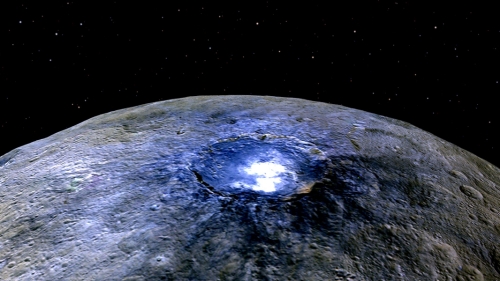
Image: This representation of Ceres’ Occator Crater in false colors shows differences in the surface composition. Red corresponds to a wavelength range around 0.97 micrometers (near infrared), green to a wavelength range around 0.75 micrometers (red, visible light) and blue to a wavelength range of around 0.44 micrometers (blue, visible light). Occator measures about 90 kilometers wide. Scientists use false color to examine differences in surface materials. The color blue on Ceres is generally associated with bright material, found in more than 130 locations, and seems to be consistent with salts, such as sulfates. It is likely that silicate materials are also present. Credit: NASA/JPL-Caltech/UCLA/MPS/DLR/IDA.
That, of course, backs up the idea that we’re dealing with a subsurface layer of salty water ice, an idea supported by the global nature of the bright spots. The Occator crater contains the brightest material found on Ceres, and it also appears to be one of the youngest surface features, with an age of about 78 million years. Remarkably, what appears to be a diffuse haze can be seen filling the floor of the crater at certain times of day.
The haze appears to be absent at dawn and dusk, while it can be seen at local noon, making Ceres, in the view of the study authors, something like a comet, where water vapor when warmed can lift particles of dust and residual ice off the surface. The Herschel space observatory reported water vapor at Ceres in 2014, a finding consistent with these observations. Remember, however, that we’re still waiting on the unambiguous detection of water ice on Ceres, so the story of the Occator haze will require more data and further analysis.
The papers are Nathues et al., “Sublimation in bright spots on (1) Ceres,” Nature 528 (10 December 2015), 237-240 (abstract) and De Sanctis et al., “Ammoniated phyllosilicates with a likely outer Solar System origin on (1) Ceres,” Nature 528 (10 December 2015), 241-244 (abstract).

ALMA: Interesting Objects in the Outer System
Two papers have appeared on the arXiv server suggesting hitherto undiscovered objects in the outer Solar System (thanks to Centauri Dreams reader Stevo Darkly for the pointer). Both papers use data harvested by the Atacama Large millimeter/submillimeter array (ALMA), an interferometer of radio telescopes in Chile’s northern high desert. Here some 66 12-meter and 7-meter radio telescopes work the sky at millimeter and submillimeter wavelengths, with targets that have ranged from galactic dust in the early universe to magnetic fields near a supermassive black hole.
ALMA’s uses closer to home are made clear in the new papers, which demonstrate that this array can be a major tool in helping us probe the outer system well into the Oort Cloud. In the first paper, the researchers draw on three periods of observation with ALMA to detect point-like emissions at different positions in two of the periods. The two emissions are thought to be the same source, considering what the authors call “the negligible probability of having identified two independent highly variable background sources.” Assuming a single source, the team dubs the object Gna, noting that it was not visible in the third observing period 42 days later.
So what exactly do we have here? If gravitationally bound, the object would be at a distance between 12 and 25 AU, most likely a Centaur with a semi-major axis between Jupiter and Neptune, though a large one, in the range of 220-800 kilometers depending on distance and albedo. The authors note that the location of the field of view (close to the galactic plane toward the star W Aquilae) may explain why the object was not seen sooner despite its size.
But there is another possibility, that Gna is unbound. “In that case,” write the authors, “the most exciting possibility is that we have observed a planetary body or brown dwarf in the outer reaches of the Oort cloud.” Which leads to recent WISE studies that found no evidence of a Saturn-class object out as far as 28000 AU, or of a Jupiter out to 82000 AU, while a Jupiter-sized brown dwarf could be excluded out to 26000 AU at the locations previously suggested by John Matese and Daniel Whitmire. The latter have argued that a large planetary body in the Oort would explain the seemingly clustered orbits of many comets.
Could Gna be that object? The paper notes the WISE data in reference to the new findings, stating that a submillimeter flux of 3 mJy at a distance of 5000-50000 AU would point to an object that has retained residual heat or generates emission of its own. It would not, in other words, absorb enough sunlight to display the measured flux. As the paper notes:
This would imply a large planet or brown dwarf and could be reconciled with the Jupiter sized brown dwarf or Saturn/Neptune size planetary limits provided by WISE (Luhman 2014), if Gna is located around or beyond ? 20000 AU.
But the high proper motion seen here seems to rule out anything beyond about 4000 AU. While unable to exclude a large gravitationally unbound body within 4000 AU, the authors think it most likely that Gna is a bound Centaur in retrograde orbit, currently between 12 and 25 AU out and with a size of 220-880 kilometers.
But we’re not through with ALMA just yet. Another set of ALMA observations ten months apart (2014-2015) by the same research team has revealed a point source that appears to share the proper motion of Alpha Centauri A and B. Is there an Alpha Centauri D? Apparently not, for at the distance of the Centauri stars, the measurements would correspond to an M2-class dwarf, a star bright enough to be clearly visible. If there were an Alpha Centauri D, we would have seen it by now.
Instead, the authors make the case that the object is a Trans Neptunian Object (TNO). From the paper:
For reasons of sensitivity (or rather, lack thereof), TNOs on highly eccentric orbits have traditionally been firstly detected when close to their perihelia. Further away, there would have remained unseen… However, a sizable population of such bodies is expected to exist at large distances from the Sun. It is clear, therefore, that ALMA with its high submm sensitivity provides presently the only existing means to detect TNOs far from their perihelia, where temperatures are merely some tens of Kelvin. There must be a vast reservoir of objects between, say, roughly 100 and 1000 AU, of which we hitherto have seen only a tiny fraction.
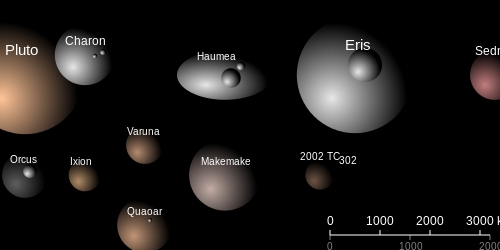
Image: An illustration of the relative sizes, albedos and colors of some of the largest known TNOs. Credit: Wikimedia Commons. Licensed under CC BY-SA 3.0.
Just what kind of an object would this be? The paper continues:
We argue that the object is most likely part of the solar system, in prograde motion, albeit at a distance too far to be detectable at other wavelengths, viz. an ETNO [Extreme Trans Neptunian Object] (? 100 AU), a hypothesized Super-Earth (? 300 AU) or a super-cool brown dwarf (? 20 000 AU).
From an ETNO to a brown dwarf is quite a range, highlighting how much we still don’t know. So we can’t say we’ve found the large perturber discussed by Matese and Whitmire, but we do have interesting work on new objects, one of which could conceivably fit the description. It will take a lot of work to learn more about the new ALMA objects, but we’re finding out how the array can fine-tune our capabilities in probing out into the Oort Cloud. If such perturbers exist, we’re going to turn them up sooner or later as we continue to map the system’s farthest depths.
The paper on Gna is Vlemmings et al., “The serendipitous discovery of a possible new solar system object with ALMA,” submitted to Astronomy & Astrophysics (preprint). The paper on the point source near Alpha Centauri in the sky is Liseau et al., “A new submm source within a few arcseconds of ? Centauri: ALMA discovers the most distant object of the solar system,” submitted to Astronomy & Astrophysics (preprint). Eric Berger offers a highly skeptical take on this work here.

Where to Look for Rocky Planets
If you were trying to identify the kind of star that should produce Earth-like planets, you’d think the task would be straightforward. Our theories of planet formation focus on a circumstellar disk around a young star out of which planets form, and we’ve already gathered evidence that gas giant worlds are more likely to form around stars that are rich in iron. Since rocky planets are rich in iron and silicon, doesn’t this mean their stars should be rich in metallic elements?
New work out of the Carnegie Institution for Science suggests that the answer is surprisingly complex. As presented by Johanna Teske at the Extreme Solar Systems III meeting in Hawaii, the team’s work has revealed that smaller planets do not require high iron content in their parent stars. In fact, looking at the abundance of 19 different elements in seven stars orbited by at least one rocky planet (these are drawn from the Kepler catalog), the team finds that rocky worlds do not preferentially form around stars rich in metallic elements like iron and silicon.
The data were taken as part of the Kepler Follow-up Observing Program and supplemented by independent observations using the 10-meter Keck telescope and the HIRES echelle spectrometer. From the paper:
The metallicities of the seven stars range from [Fe/H] = ?0.30 to +0.15, further demonstrating that small planets form around stars with both low and high metallicities… The abundances of 15 elements are compared to those of a Galactic disk population that includes stars with and without known planets. The abundances of the Kepler planet host stars fall along the Galactic trends, suggesting that stars with small planets have compositions that are typical of the Galactic disk.
Stars with small planets, then, are nothing exceptional in terms of their metallicity. This implies they are common throughout the galaxy. The paper goes on:
Moreover, comparing the abundance distributions of the Kepler planet host stars to a sample of stars with no detected planets, a sample of Neptune- and super-Earth-size planet hosts, and a sample of Jupiter-type giant planet hosts, reveals that the former three – Kepler host stars, stars without known planets, and the Neptune and super-Earth-size planet hosts – may have similar compositions, whereas the Kepler host stars appear to have compositions that are less enhanced than those of Jupiter-type planet hosts.
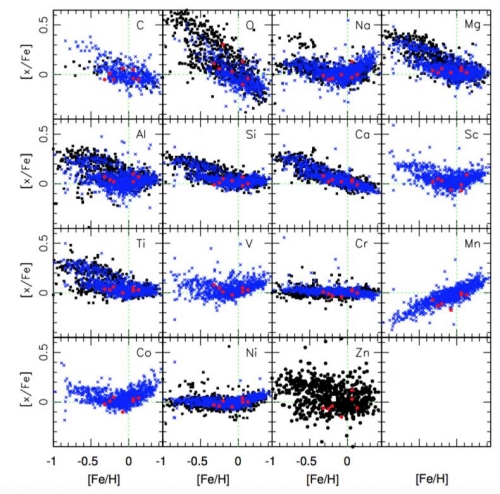
Image: This figure from the paper shows the abundance of different elements in stars versus their abundances of iron. In each square, you can see a plot of the abundance of one element (represented by [x/Fe]) against the abundance of iron (represented by [Fe/H]). Each red dot, black square, or blue X represents a star. The red dots are the small planet-hosting stars studied in this new work. You can see how they do not stand out from the rest of the stars, which were studied in other publications, some of which host planets and some of which have no known planets. The green dashed lines show these values for our Sun. Credit: NASA Ames/JPL-Caltech/Tim Pyle.
Small, rocky planets appear to form around stars with a wide range of elements, whereas gas giants are more likely around stars rich in iron. Teske adds in this Carnegie news release that the results are exciting “…because they mean that small planets are very common and chemically diverse.” What we don’t yet know is whether the planet formation process depletes stars of some of the elements that become concentrated in the planets. None of the seven stars the team studied show a depletion signature, but if subsequent work does uncover such a trend, then looking for stars with specific chemical depletions could be a useful planet-hunting tool.
Does the architecture of a solar system play a role in these trends? With the exception of two planets, the planets of all the stars investigated have semimajor axes smaller than Mercury’s. As the paper notes, the small sample size here limits the statistical significance of the results, so the obvious next step is generating a larger sample of stars with small planets and performing abundance analyses on this set. We’re fortunate that the Kepler mission has identified numerous small planets whose host stars can now be subjected to this kind of study.
The paper is Schuler et al., “Detailed Abundances of Stars with Small Planets Discovered by Kepler I: The First Sample,” accepted for publication in The Astrophysical Journal (preprint).

A Bill for a Starfaring Future
Back in 2012 I reported on Peter Garretson’s What Our Civilization Needs is a Billion Year Plan, an essay advocating a robust human expansion to the stars. Lt. Col. Garretson lives and breathes futuristic issues. A transformational strategist for the US Air Force, he has served as an airpower strategist and strategic policy advisor to the Chief of Staff of the Air Force on his Strategic Studies Group, the Chief of Irregular Warfare Strategy, Plans and Policy, and spent four years as the Chief of Future Technology for HQ USAF Strategic Planning. He is currently an Instructor of Joint Warfare at Air Command and Staff College and the lead for Space Horizons, Air University’s endeavor to “re-imagine spacepower in the age of asteroid mining.” A long-time space advocate, he has written widely on issues ranging from planetary defense to solar power; you can follow his work at his website: http://www.petergarretson.com/. In today’s open letter to Centauri Dreams, he lays down a first draft for a bill aimed at energizing NASA’s role in developing the technologies needed for starflight.
by Peter A. Garretson

Sooner or later we are going to discover an Earth-like exoplanet, and when we do, we are going to want to go there. The 100 Year Starship, Icarus Interstellar, Tennessee Valley Interstellar Workshop, Initiative for Interstellar Studies, Tau Zero and Centauri Dreams are all catalyzing terrific work that forwards general spacefaring and space industrial capabilities. And like NASA’s BPP more low-dollar work could lead to great NIAC-like thinking and advances. Those of us who already know that this should be our direction should have ready legislation to move forward. Here is an initial draft of what might be in such a bill:
Gene Roddenberry Memorial America Starfaring / Starship bill.
It is the will of the Congress that America should become a star-faring civilization, bringing new life to uninhabited worlds, ensuring our continuity, security and prosperity for our posterity. It is the will of the American people for America to develop the capability to “seek out new life and new civilizations, to boldly go where no one has gone before.”
And if it is the dream of Congress, by America’s Quadricentennial (2176) America will have reached another star.
To that end, NASA, the DOE, and DoD are authorized and encouraged, in concert, and in concert with private industry and academia to:
- Develop technologies and capabilities to enable interstellar probes
- Develop propulsion and life support capabilities that could enable a manned mission in a single human lifetime
- Develop off-Earth industrial capability to construct and launch such missions through space resource utilization (space mining and space power)
- Enable thriving off-Earth communities and a space economy that could support the expense of such a mission
NASA is directed to:
- Sponsor a Conference every two years to review the most exciting and profitable destinations and present visions and ideas to the public
- Review and present to the public progress and conceptual designs for interstellar missions
- Present to Congress, every two years, the most exciting and profitable destinations beyond our heliopause, and progress in the necessary technology.
//Signed//
PETER A. GARRETSON, Lt Col, USAF
Air University Space Horizons Activity Lead

The Best Pluto Imagery Yet
I finally have a landscape to attach to Larry Niven’s classic “Wait It Out,” a tale of shipwreck on Pluto. The New Horizons imagery is giving us resolutions of 77-85 meters per pixel, so that we can, as this JHU/APL news release reminds us, see features less than half the size of a city block. The one below is the one that has me captivated because it reminds me of the Niven tale, in which a team of astronauts becomes stranded on Pluto’s surface, and the protagonist deliberately exposes himself to the vacuum to place himself into cryogenic storage.
A man can stay conscious for tens of seconds in vacuum. If I moved fast, I could get out of my suit in that time. Without that insulation to protect me, Pluto’s black night would suck warmth from my body in seconds. At 50° Absolute, I’d stay in frozen storage until one version or another of the Day of Resurrection.
And then this:
A superconductor is what I am. Sunlight raises the temperature too high, switching me off like a damned machine at every dawn. But at night my nervous system becomes a superconductor. Currents flow; thoughts flow; sensations flow. Sluggishly. The one hundred and fifty-three hours of Pluto’s rotation flash by in what feels like fifteen minutes. At that rate I can wait it out.
Niven wrote “Wait It Out” in 1968, published it in a science fiction convention program book, then in an anthology edited by Robert Silverberg, before its 1971 publication in All the Myriad Ways, perhaps my favorite of all the Niven short story collections. Ever since reading it, I’ve thought about what the frozen astronaut would see, described by Niven as a row of frozen mountains over which “the stars pour up in singletons and clusters and streamers…”
Now I can envision our protagonist on Sputnik Planum, on a relatively smooth block of nitrogen crustal ice looking out toward the al-Idrisi mountains. The images below were all made with New Horizons’ Long Range Reconnaissance Imager (LORRI) about fifteen minutes before the spacecraft’s closest approach to Pluto, at a range of 17,000 kilometers. We’re seeing the results of LORRI recording images every three seconds using unusually short exposures.
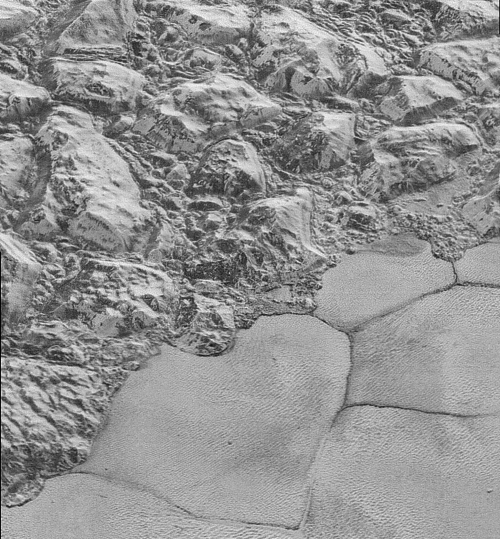
Image: In this highest-resolution image from NASA’s New Horizons spacecraft, great blocks of Pluto’s water-ice crust appear jammed together in the informally named al-Idrisi mountains. Some mountain sides appear coated in dark material, while other sides are bright. Several sheer faces appear to show crustal layering, perhaps related to the layers seen in some of Pluto’s crater walls. Other materials appear crushed between the mountains, as if these great blocks of water ice, some standing as much as 2.5 kilometers high, were jostled back and forth. The mountains end abruptly at the shoreline of the informally named Sputnik Planum, where the soft, nitrogen-rich ices of the plain form a nearly level surface, broken only by the fine trace work of striking, cellular boundaries and the textured surface of the plain’s ices (which is possibly related to sunlight-driven ice sublimation). This view is about 80 kilometers wide. Credit: NASA/Johns Hopkins University Applied Physics Laboratory/Southwest Research Institute.
The magnitude of New Horizons’ success is reflected in the quality of this and the images that follow below, which are about five times better than the best images of Triton we received from Voyager 2 back in 1989. And principal investigator Alan Stern has made the point that when we were first exploring Mars and Venus, it took decades to develop the ability to see with this level of detail. Our instrumentation has come a long way, and so has this one-shot flyby mission, which has demonstrated how much can be done even when an orbiter is not available.
As to that view that reminds me of the Niven tale, New Horizons team member John Spencer describes it well:
“The mountains bordering Sputnik Planum are absolutely stunning at this resolution. The new details revealed here, particularly the crumpled ridges in the rubbly material surrounding several of the mountains, reinforce our earlier impression that the mountains are huge ice blocks that have been jostled and tumbled and somehow transported to their present locations.”
Two other recently released images follow. With New Horizons now 167 million kilometers beyond Pluto and 5.2 billion kilometers from the Earth, all systems remain operational and we can expect still more imagery from this data set over the next few days.
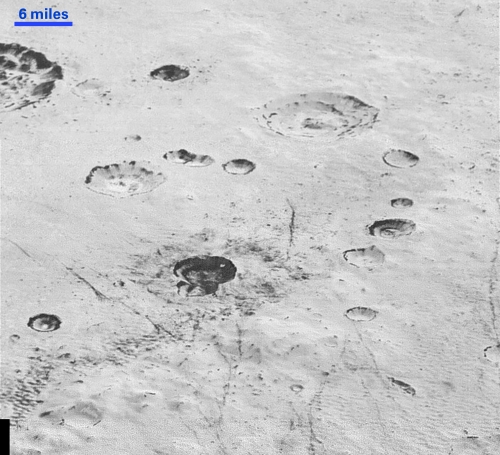
Image: Notice the layering in the interior walls of many craters (the large crater at upper right is a good example) – layers in geology usually mean an important change in composition or event but at the moment New Horizons team members do not know if they are seeing local, regional or global layering. The darker crater in the lower center is apparently younger than the others, because dark material ejected from within – its “ejecta blanket” – have not been erased and can still be made out. The origin of the many dark linear features trending roughly vertically in the bottom half of the image is under debate, but may be tectonic. Most of the craters seen here lie within the 250-kilometer-wide Burney Basin, whose outer rim or ring forms the line of hills or low mountains at bottom. The basin is informally named after Venetia Burney, the English schoolgirl who first proposed the name “Pluto” for the newly discovered planet in 1930. Credit: NASA/Johns Hopkins University Applied Physics Laboratory/Southwest Research Institute.
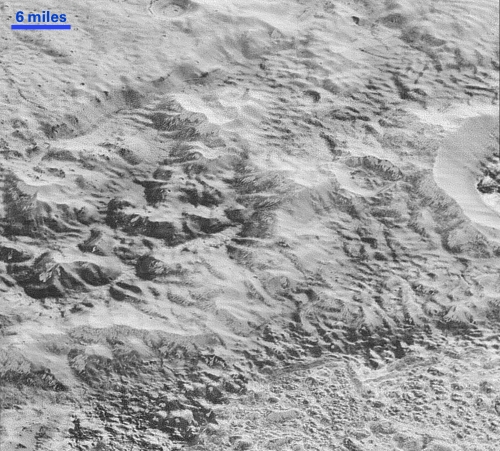
Image: This image shows how erosion and faulting has sculpted this portion of Pluto’s icy crust into rugged badlands. The prominent 2-kilometer-high cliff at the top, running from left to upper right, is part of a great canyon system that stretches for hundreds of kilometers across Pluto’s northern hemisphere. New Horizons team members think that the mountains in the middle are made of water ice, but have been modified by the movement of nitrogen or other exotic ice glaciers over long periods of time, resulting in a muted landscape of rounded peaks and intervening sets of short ridges. At the bottom of this 80-kilometer-wide image, the terrain transforms dramatically into a fractured and finely broken up floor at the northwest margin of the giant ice plain informally called Sputnik Planum. Credit: NASA/Johns Hopkins University Applied Physics Laboratory/Southwest Research Institute.


